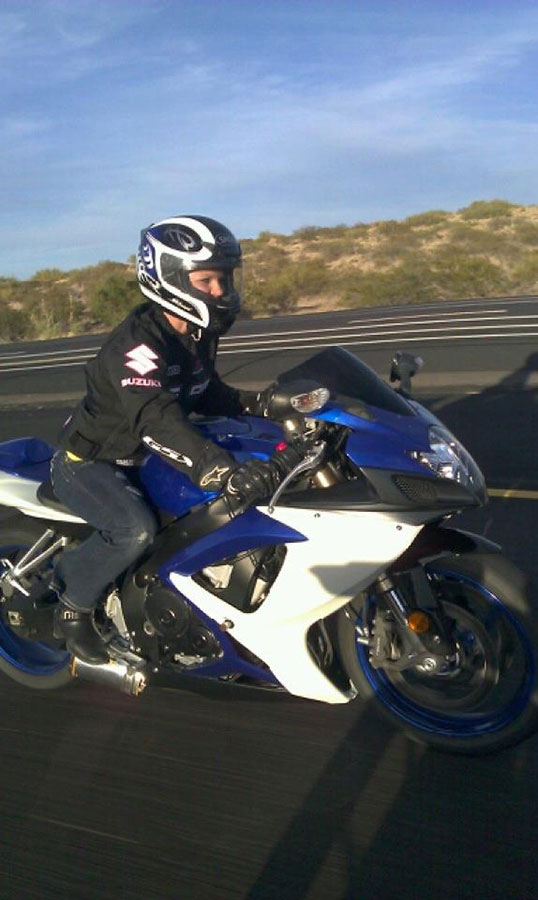EL PASO — The 2006 Suzuki GSXR 600 roars down the I-10 freeway going 60 mph at 6:30 a.m. on a weekday and exits on Schuster Avenue. The woman at the wheel, Tory Lewis, a fit 5’ 2’’ blonde, then turns left onto Hawthorne from Schuster Avenue entering the University of Texas at El Paso campus. Her bike comes to an abrupt stop behind the Administrative Building and she parks in a spot designated for motorcycles.
She removes her dark-blue helmet and is ready to start her day as she walks towards her graphic and design fundamentals class located in the Liberal Arts Building.
“I just love how I’m able to feel the speed,” said Lewis, a medical engineering student at UTEP.

Tory Lewis learnt to ride a motorcycle at age 15 and hasn't stop since. (Alejandra Gonzalez/Borderzine.com)
Lewis, 28, was born and raised in Michigan and served in the United States Army for about seven years before being stationed at Fort Bliss in April of 2005.
Growing up around motorcycles motivated Lewis to learn to ride at the age of 15 and she hasn’t been able to get off since.
She bought the Suzuki, her first motorcycle, in 2006 and is proud to say she has never been in an accident.
“I always take precautions and I wear my safety gear,” she said. “I have also taken the motorcycle safety course and the advanced one.”
She understands it’s a risk to ride a motorcycle because no matter how safely she drives other vehicles are unpredictable and larger vehicles sometimes do not see her.
And she remembers getting pulled over by a police officer for speeding one time. The officer acted surprised when she removed her helmet. “He said he never expected he was pulling over a girl and talked about it nonstop,” she chuckled.
Lewis’ mother, Vickie Knake, 50, has also been riding since the age of 15 and has always been a member of motorcycle clubs. She currently lives in Baldwin, Michigan, and now only rides for fun and occasionally attends motorcycle events. Knake said a lot has changed since she started riding as a teenager.
“Riding used to be exiting and free. Now it’s a money maker and (full of) politics,” said Knake, explaining that most motorcycles clubs and events now seem to focus on making money rather than cruising and enjoying the ride.
El Pasoan Timothy Daniels, 44, has been riding since he was 18. He likes to ride with Lewis, and sometimes jokes about being a better driver than women motorcyclists. He has been a member of various motorcycle clubs for about seven years and is currently a member of the Moto Family, a driving club created about two years ago. Moto Family has 18 members, mainly men, and just three women members. The club participated in the Toys for Tot’s Bike Run last year in Las Cruces. Bike members usually cruise the city in groups when time allows, and try to ride together every Sunday morning depending on the weather.
“We treat women just how we treat the guys in the club,” Daniels said. “No one is better than anyone else.”
He added that although men have always outnumbered women in the club, the few female riders who join like to stick around.
Although accidents are common among motorcycle drivers, the sex of the rider is usually not a factor. Most motorcycle-related deaths occur because the riders aren’t wearing a helmet, according to accident statistics. What matters most is that drivers take precautions like driving safely and wearing a helmet.
There were 426 motorcycle deaths in Texas in 2009, according to the Texas Department of Transportation. This is a 13.6 percent increase from the 375 motorcycle deaths recorded in 2007, according to the National Highway Traffic Safety Administration (NHTSA). Sixty percent of these bike drivers were not wearing helmets and 39 percent of the motorcyclists killed had a blood alcohol level greater than .08.
According to NHTSA, motorcycle riders are 35 times more likely to be in traffic accidents than someone driving a passenger car. The agency does not break down the statistics for men and women motorcycle drivers.
A possible factor in the increase of motorcycle accidents is that the number of states requiring riders to wear helmets has decreased in the past 40 years. In the 1970s, for example, 47 states had laws requiring the use of helmets by motorcycle riders; today only 19 states have a law requiring helmets. The rest of the states, including Texas, only require riders to wear helmets partially, meaning once they reach a certain age. Here is a map from the Insurance Institute for Highway Safety showing helmet laws in all 50 states. http://www.iihs.org/laws/mapmotorcyclehelmets.aspx
Although some men claim that women don’t drive as well as men, gender does not appear to be a factor in accidents and motorcycle deaths.
“I was about to sell my bike a few years ago because of how dangerous it is and all the deaths (I read about) but I wasn’t able to,” Lewis said.
“You’re always going to have accidents, either on your motorcycle or car, and you just have to be as cautious as you can,” she said. “I enjoy riding too much; it’s hard to get rid of something you have had almost your entire life.”

